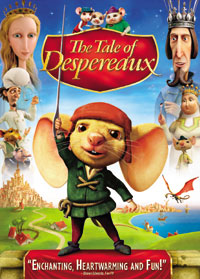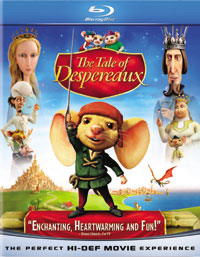


DVDSleuth.com is your source for daily DVD news and reviews.


The Tale of Despereaux (2008)
Universal Studios Home Entertainment
DVD Released: 4/7/2009
All Ratings out of ![]()
![]()
![]()
![]()
![]()
Movie: ![]()
![]() 1/2
1/2
Video: ![]()
![]()
![]()
![]() 1/2
1/2
Audio: ![]()
![]()
![]()
![]() 1/2
1/2
Extras: ![]()
![]()
Review by Mike Long, Posted on 3/28/2009
When I first saw the trailer for The Tale of Despereaux, my immediate thought was, "That look's very original and unique. I hope that it doesn't get lost amongst all of the other CG animated films out there." Well, of course, it did, as the film opened on nearly 2800 screens in the U.S., but only brought in about $10 millions its first weekend, which was surprising considering the fact that the movie is based on an award-winning children's book. At the time, I assumed that this was another case of the American viewing public ignoring something artistic. However, now that I've seen the film, I have some other theories on why the movie didn't bring in the masses.
The Tale of Despereaux takes places long ago in the kingdom of Dor. Dor was famous for its soups (?!) and all of its citizens loved soup. Every year, the King's chef, Andre (voiced by Kevin Kline), would unveil a new soup for the king. As the story opens, a ship carrying a rat named Roscuro (voiced by Dustin Hoffman) docks in Dor, and Roscuro is enthralled by the soup celebration. He's so enchanted in fact, that he makes his way into the castle so that he can observe the ceremony. But, just as the soup is being served to the Queen, Roscuro falls into her bowl. Seeing this causes the Queen to die. The King's men chase Roscuro and he falls into the depths of the castle. In his grief, The King outlaws soup and rats, and then refuses to leave the castle. A great drought overtakes the kingdom.
Meanwhile, in Mousetown (which is inside the castle), a mouse named Despereaux (voiced by Matthew Broderick) has been born. The first things that the other mice notice about Despereaux is that he's quite small and has huge ears. His teacher becomes concerned when Despereaux doesn't show any fear and doesn't learn to cower like the other mice. Despereaux roams the castle and meets Princess Pea (voiced by Emma Watson) and learns of the terrible things which have befallen the kingdom. When it's learned that Despereaux has had the courage to speak to humans, he's banned from Mousetown. How can this little mouse survive on his own?
Upon viewing The Tale of Despereaux, I realized that my instincts about the trailer had been correct, the movie is unique and, in some ways, daring. The most noticeable aspect is the style of animation. Instead of using bright colors to catch the attention of children, the makers of this film have gone for a much softer palette. On the extras included on this DVD, they say that they wanted the movie to look like a painting, and it does. The characters have a stylized look, but the level of detail is very impressive, especially things such as Despeareaux's fur. The movie also takes a chance by not introducing the title character until over 15 minutes into the movie. I consider myself to be a patient person, and even I was saying, "Hey! Is there going to be any Despereaux in your Despeareaux movie?!"
However, the makers of The Tale of Despereaux may have been too daring with the script. I have not read the source novel, but it feels as if at least two books have been shoved into this movie. Given the banality of most of the movies aimed at children, one probably shouldn't fault a movie for being complicated, but there is simply too much here. And what is here isn't detailed enough. Here's the perfect example -- At the very beginning of the film, when we are still getting used to the fact that the narrator has been talking about soup for quite some time, Chef Andre opens a cookbook and a suddenly a creature made of vegetables (voiced by Stanley Tucci) appears and begins to talk to him. We are never told what this entity is, where it came from, what it is doing exactly etc. (My daughter has read the book and stated that it's a genie, but there's no explanation like that in the movie.) Then, we have the character of Miggery (voiced by Tracey Ullman), Princess Pea's servant. We get some of her backstory, but is she truly evil, simply jealous, ignorant, or what. (Again, from the book, she's hard of hearing. That's hinted at in the film, but only when rats or mice are talking to her, so I assumed that she couldn't hear their tiny voices.) The Tale of Despereaux is actually the tale of Despereaux and several other characters and the whole mish-mash becomes too top-heavy for its own good.
The Tale of Despereaux is a disappointment. The movie has a great, unique look and the voice acting is top-notch. (I thought that Hoffman only had a small role, but he's in most of the film.) However, the story comes apart at the seams. Youngsters may be overwhelmed by the multi-layered, while adults will be surprised by how unemotional the whole thing is. And everyone will be stymied by the prevalence of soup in the film.
The Tale of Despereaux doesn't cower on DVD courtesy of Universal Studios Home Entertainment. The film has been letterboxed at 2.35:1 and the transfer is enhanced for 16 x 9 TVs. The image is sharp and clear for the most part, but some shots look a bit hazy, which is nothing short of odd for an animated film. The colors look very good, most notably reds and blues. There are no defects from the source material. The image is somewhat flat when compared to the Blu-ray Disc version. The DVD carries a Dolby Digital 5.1 audio track which provides clear dialogue and sound effects. The stereo effects are good and show a nice amount of separation. The surround sound effects aren't as prevalent, but they are impressive, most notably in crowd scenes. There are some nice subwoofer effects during the finale.
The Tale of Despereaux DVD contains only a few extras. "The Tale of The Tale of Despereaux" (12 minutes) is a making-of featurette which contains comments from the producers, directors and writer Kate DiCamillo. We also hear from the voice actors, and we get to see them at work. The piece then examines the animation method and the painting-like look was achieved. "Interactive Map of the Kingdom of Dor" allows the viewer to learn more about the characters and locations in the film. "Top Ten Uses for Oversized Ears" (1 minute) is exactly what it sounds like (Don't look for this one on Letterman). There are also two set-top games, "Despereaux's Quest Game" and "Build-a-Boldo Game".
Universal Studios Home Entertainment has also brought The Tale of
Despereaux to Blu-ray Disc.
The film has been letterboxed at 2.35:1 and the Disc contains a 1080p HD
transfer which runs at an average of 25 Mbps. The image is very sharp and clear,
showing no grain and no defects from the source material. The haze present on
the DVD version is not present here. The image has an incredible amount of depth
which only enhances the 3-D CG animation process. The level of detail is quite
good (just look at Despeareaux's fur) and the colors look very nice. The Disc
offers a DTS-HD Master Audio 5.1 track which runs at 48 kHz and an average of
4.0 Mbps. The audio here is quite impressive, as this is a surprisingly muscular
track for a family film. The stereo effects show a good amount of detail and are
nearly constant. The in-film music sounds great. The surround sound effects,
most notably during the finale are spacious and effective. The subwoofer effects
aren't wall-shaking, but they do add to the movie.
The extras on the Blu-ray Disc are a bit different from those
found on the DVD. In addition to "The Tale of The Tale of Despereaux" and
"Top Ten Uses for Oversized Ears", we get several other features. The Disc
offers two "Deleted Songs", "It's Great to Be a Rat" and "Soup", which run about
5 minutes. These are offered in storyboard form and would have given the film a
much different feel. We get "Scene Progressions" (35 minutes) for six scenes,
which show how the film went from script to storyboard to layout to animation to
final lighting. The Disc contains "Make Your Own Soup Game" and a "Card
Creator". The "U-Control" offers two choices. "Live Action" gives us a behind
the scenes look at the voice actors at work, while "Animatic" provides animated
storyboards for certain scenes.
Review Copyright 2009 by Mike Long